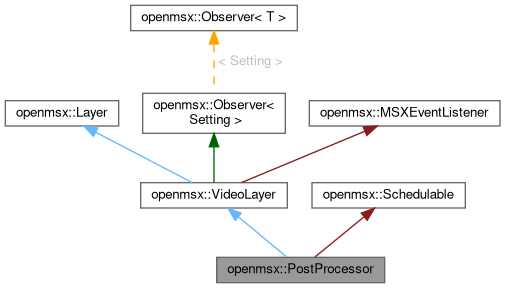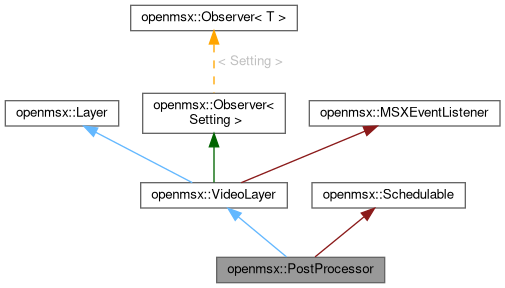A post processor builds the frame that is displayed from the MSX frame, while applying effects such as scalers, noise etc. More...
#include <PostProcessor.hh>


Public Member Functions | |
| PostProcessor (MSXMotherBoard &motherBoard, Display &display, OutputSurface &screen, const std::string &videoSource, unsigned maxWidth, unsigned height, bool canDoInterlace) | |
| ~PostProcessor () override | |
| void | paint (OutputSurface &output) override |
| Paint this layer. | |
| std::unique_ptr< RawFrame > | rotateFrames (std::unique_ptr< RawFrame > finishedFrame, EmuTime::param time) |
| Sets up the "abcdFrame" variables for a new frame. | |
| void | setSuperimposeVideoFrame (const RawFrame *videoSource) |
| Set the Video frame on which to superimpose the 'normal' output of this PostProcessor. | |
| void | setSuperimposeVdpFrame (const FrameSource *vdpSource) |
| Set the VDP frame on which to superimpose the 'normal' output of this PostProcessor. | |
| void | setRecorder (AviRecorder *recorder_) |
| Start/stop recording. | |
| bool | isRecording () const |
| Is recording active. | |
| FrameSource * | getPaintFrame () const |
| Get the frame that would be displayed. | |
| void | takeRawScreenShot (unsigned height, const std::string &filename) override |
| Create a raw (=non-post-processed) screenshot. | |
| CliComm & | getCliComm () |
 Public Member Functions inherited from openmsx::VideoLayer Public Member Functions inherited from openmsx::VideoLayer | |
| VideoLayer (const VideoLayer &)=delete | |
| VideoLayer (VideoLayer &&)=delete | |
| VideoLayer & | operator= (const VideoLayer &)=delete |
| VideoLayer & | operator= (VideoLayer &&)=delete |
| int | getVideoSource () const |
| Returns the ID for this VideoLayer. | |
| int | getVideoSourceSetting () const |
| void | setVideo9000Active (int video9000Source_, Video9000Active active) |
| bool | needRender () const |
| bool | needRecord () const |
 Public Member Functions inherited from openmsx::Layer Public Member Functions inherited from openmsx::Layer | |
| virtual | ~Layer ()=default |
| ZIndex | getZ () const |
| Query the Z-index of this layer. | |
| bool | isActive () const |
| Coverage | getCoverage () const |
| Query the coverage of this layer. | |
| void | setDisplay (LayerListener &display_) |
| Store pointer to Display. | |
Additional Inherited Members | |
 Public Types inherited from openmsx::VideoLayer Public Types inherited from openmsx::VideoLayer | |
| enum class | Video9000Active { NO , FRONT , BACK } |
 Public Types inherited from openmsx::Layer Public Types inherited from openmsx::Layer | |
| enum class | ZIndex { BACKGROUND , MSX_PASSIVE , MSX_ACTIVE , OSDGUI , IMGUI } |
| Determines stacking order of layers: layers with higher Z-indices are closer to the viewer. More... | |
| enum class | Coverage { FULL , PARTIAL , NONE } |
| Describes how much of the screen is currently covered by a particular layer. More... | |
 Protected Member Functions inherited from openmsx::VideoLayer Protected Member Functions inherited from openmsx::VideoLayer | |
| VideoLayer (MSXMotherBoard &motherBoard, const std::string &videoSource) | |
| ~VideoLayer () override | |
| void | update (const Setting &setting) noexcept override |
 Protected Member Functions inherited from openmsx::Layer Protected Member Functions inherited from openmsx::Layer | |
| Layer (Coverage coverage_, ZIndex z_) | |
| Construct a layer. | |
| void | setCoverage (Coverage coverage_) |
| Changes the current coverage of this layer. | |
| void | setZ (ZIndex z) |
| Changes the current Z-index of this layer. | |
 Protected Member Functions inherited from openmsx::Observer< Setting > Protected Member Functions inherited from openmsx::Observer< Setting > | |
| Observer ()=default | |
| ~Observer ()=default | |
| Observer (const Observer &)=delete | |
| Observer (Observer &&)=delete | |
| Observer & | operator= (const Observer &)=delete |
| Observer & | operator= (Observer &&)=delete |
| virtual void | subjectDeleted (const Setting &) |
Detailed Description
A post processor builds the frame that is displayed from the MSX frame, while applying effects such as scalers, noise etc.
Definition at line 34 of file PostProcessor.hh.
Constructor & Destructor Documentation
◆ PostProcessor()
| openmsx::PostProcessor::PostProcessor | ( | MSXMotherBoard & | motherBoard, |
| Display & | display, | ||
| OutputSurface & | screen, | ||
| const std::string & | videoSource, | ||
| unsigned | maxWidth, | ||
| unsigned | height, | ||
| bool | canDoInterlace | ||
| ) |
Definition at line 44 of file PostProcessor.cc.
References gl::ShaderProgram::attach(), openmsx::Subject< T >::attach(), gl::ShaderProgram::bindAttribLocation(), openmsx::RenderSettings::getHorizontalStretch(), openmsx::RenderSettings::getHorizontalStretchSetting(), openmsx::RenderSettings::getNoise(), openmsx::RenderSettings::getNoiseSetting(), and gl::ShaderProgram::link().
◆ ~PostProcessor()
|
override |
Definition at line 89 of file PostProcessor.cc.
References openmsx::Subject< T >::detach(), getCliComm(), openmsx::RenderSettings::getHorizontalStretchSetting(), openmsx::RenderSettings::getNoiseSetting(), openmsx::CliComm::printWarning(), and openmsx::AviRecorder::stop().
Member Function Documentation
◆ getCliComm()
| CliComm & openmsx::PostProcessor::getCliComm | ( | ) |
Definition at line 115 of file PostProcessor.cc.
References openmsx::Display::getCliComm().
Referenced by rotateFrames(), and ~PostProcessor().
◆ getPaintFrame()
|
inline |
Get the frame that would be displayed.
E.g. so that it can be superimposed over the output of another PostProcessor, see setSuperimposeVdpFrame().
Definition at line 94 of file PostProcessor.hh.
◆ isRecording()
|
inline |
Is recording active.
ATM used to keep frameskip constant during recording.
Definition at line 88 of file PostProcessor.hh.
◆ paint()
|
overridevirtual |
Paint this layer.
Implements openmsx::Layer.
Definition at line 213 of file PostProcessor.cc.
References openmsx::RenderSettings::_3D, gl::context, openmsx::GLScalerFactory::createScaler(), gl::matMxN< M, N, T >::data(), find_unguarded(), gl::BufferObject::get(), openmsx::RenderSettings::getDisplayDeform(), openmsx::RenderSettings::getGlow(), openmsx::FrameSource::getHeight(), openmsx::RenderSettings::getHorizontalStretch(), openmsx::RenderSettings::getInterleaveBlackFrame(), openmsx::OutputSurface::getLogicalSize(), openmsx::RenderSettings::getScaleAlgorithm(), openmsx::OutputSurface::getViewOffset(), and openmsx::OutputSurface::getViewSize().
◆ rotateFrames()
| std::unique_ptr< RawFrame > openmsx::PostProcessor::rotateFrames | ( | std::unique_ptr< RawFrame > | finishedFrame, |
| EmuTime::param | time | ||
| ) |
Sets up the "abcdFrame" variables for a new frame.
TODO: The point of passing the finished frame in and the new workFrame out is to be able to split off the scaler application as a separate class.
- Parameters
-
finishedFrame Frame that has just become available. time The moment in time the frame becomes available. Used to calculate the framerate for recording (depends on PAL/NTSC, frameskip).
- Returns
- RawFrame object that can be used for building the next frame.
Definition at line 330 of file PostProcessor.cc.
References openmsx::AviRecorder::addImage(), getCliComm(), openmsx::RenderSettings::getDeflicker(), openmsx::RenderSettings::getDeinterlace(), openmsx::RenderSettings::getInterleaveBlackFrame(), openmsx::VideoLayer::needRecord(), openmsx::FrameSource::NONINTERLACED, openmsx::FrameSource::ODD, openmsx::CliComm::printWarning(), random_float(), openmsx::Schedulable::setSyncPoint(), and openmsx::AviRecorder::stop().
◆ setRecorder()
|
inline |
Start/stop recording.
- Parameters
-
recorder_ Finished frames should be pushed to this AviRecorder. Can also be nullptr, meaning recording is stopped.
Definition at line 83 of file PostProcessor.hh.
◆ setSuperimposeVdpFrame()
|
inline |
Set the VDP frame on which to superimpose the 'normal' output of this PostProcessor.
This is similar to the method above, except that now the superimposing is done before scaling. IOW both frames get scaled.
Definition at line 74 of file PostProcessor.hh.
◆ setSuperimposeVideoFrame()
|
inline |
Set the Video frame on which to superimpose the 'normal' output of this PostProcessor.
Superimpose is done (preferably) after the normal output is scaled. IOW the video frame is (preferably) left unchanged, though exceptions are e.g. scalers that render scanlines, those are preferably also visible in the video frame.
Definition at line 65 of file PostProcessor.hh.
◆ takeRawScreenShot()
|
overridevirtual |
Create a raw (=non-post-processed) screenshot.
The 'height' parameter should be either '240' or '480'. The current image will be scaled to '320x240' or '640x480' and written to a png file.
Implements openmsx::VideoLayer.
Definition at line 160 of file PostProcessor.cc.
References openmsx::PNG::saveRGBA(), and VLA.
The documentation for this class was generated from the following files: